As I write this I'm getting over a cold. Getting sick as an adult really sucks, but when you're a kid it's awesome; you get to skip out on school and play video games all day. I decided to take up the extra free time my sickness afforded me to play the original Spyro the Dragon trilogy in full and shoot me in the head if these games aren't some of the greatest of all time. I guess, in that respect, getting sick as an adult isn't so bad either.
If you're reading this you are likely, at the absolute least, vaguely interested in these games. This is probably not the first time you've heard someone talk about them. Hell, it might not even be the first time you've heard me talk about them. Those old videos of mine could really use an update…
I'm going to give away my thoughts right now: The first game is my favorite in the trilogy and is as close as most platformers get to being perfect. I consider Spyro 2 and 3 to be almost equal in terms of quality with very, very slight preference given to Spyro 2. I think Spyro 3 is still a fantastic game that is worth playing, so that should clue you in to how I feel about the other two.
Also, 'cause I don't know where to mention this, I did not actually grow up with these games. I grew up playing the Crash games and only ever saw glimpses of Spyro. They were games that I always wanted to play but just never got around to. I remember playing the Spyro 3 demo on Crash Bash and really enjoying the skateboarding. As I say that I am just remembering that I actually did play one of the weird, isometric GBA games (I believe it was Season of Flame). My first proper experience with Spyro the Dragon was via the PlayStation Network. I remember putting the first game on my PSP and playing it that way. I must have been around 12 years old or so at that time. I didn't play Spyro 2 and 3 until a few years later. I didn't actually like them all that much when I first played them, but I warmed up to them with time.
Let's not waste any more time. Click on the links to skip to the reviews of Spyro 2: Ripto's Rage, Spyro: Year of the Dragon, or Spyro: Reignited Trilogy.
Spyro the Dragon (1998)
This is gonna sound kinda random but hear me out for a second…
Not too long ago I had the pleasure of watching a movie called Kiki's Delivery Service. It's quickly becoming one of my all-time favorites. Kiki operates at an incredibly low level of stress, yet at no point does it feel like you're watching a 'kiddie' movie. There is still some conflict in the movie, but it doesn't unravel in the conventional way. The surface-level story is incredibly simple, but beneath that is a shockingly deep and thought-provoking movie. The result is a movie that I really think anyone can admire.
I bring this up because, to me, Spyro the Dragon captures this energy in game form.
The visuals are wholesome and inviting, but so finely crafted that even the most pretentious of art snobs can appreciate them. This game's use of color is subtle, but very clever. This is consistent between all three games but is especially noticeable in Spyro 1. In this game's case, each of the different home worlds have a unique color palette.
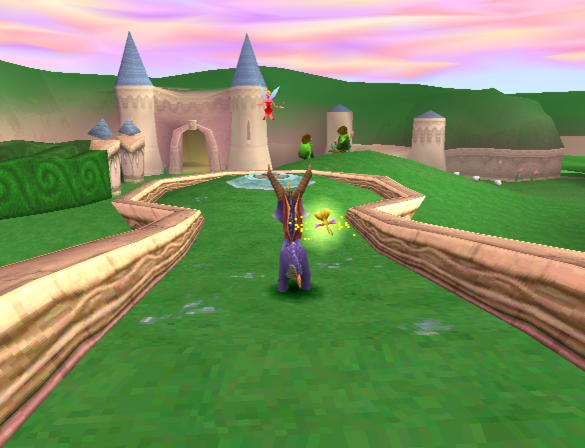

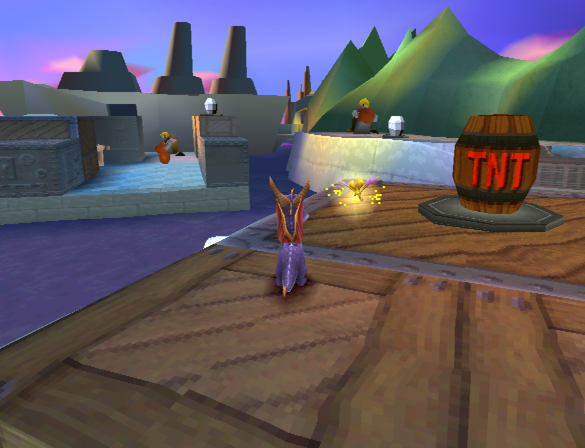
A level's core palette should contain only two or three base colors. Using these base colors, a level's detail is then defined using various shades and values along with small amounts of complimentary or contrasting colors. Be careful when extending this core palette because using too many colors can lessen the impact of any one color and you end up with emotional mud - just as if you mixed too many different colors of paint together.
This quote comes from an old article by Craig Stitt, one of the artists for the original Spyro trilogy. I can't emphasize enough the subtlety of this effect; it's what sets Spyro apart from so many other games of the genre. Compare the visuals of the first Spyro game to… literally any Mario game released within the last 20 years. Super Mario 3D World is a really fun game, but it is ugly. Personally, I can never stomach the game for more than an hour.
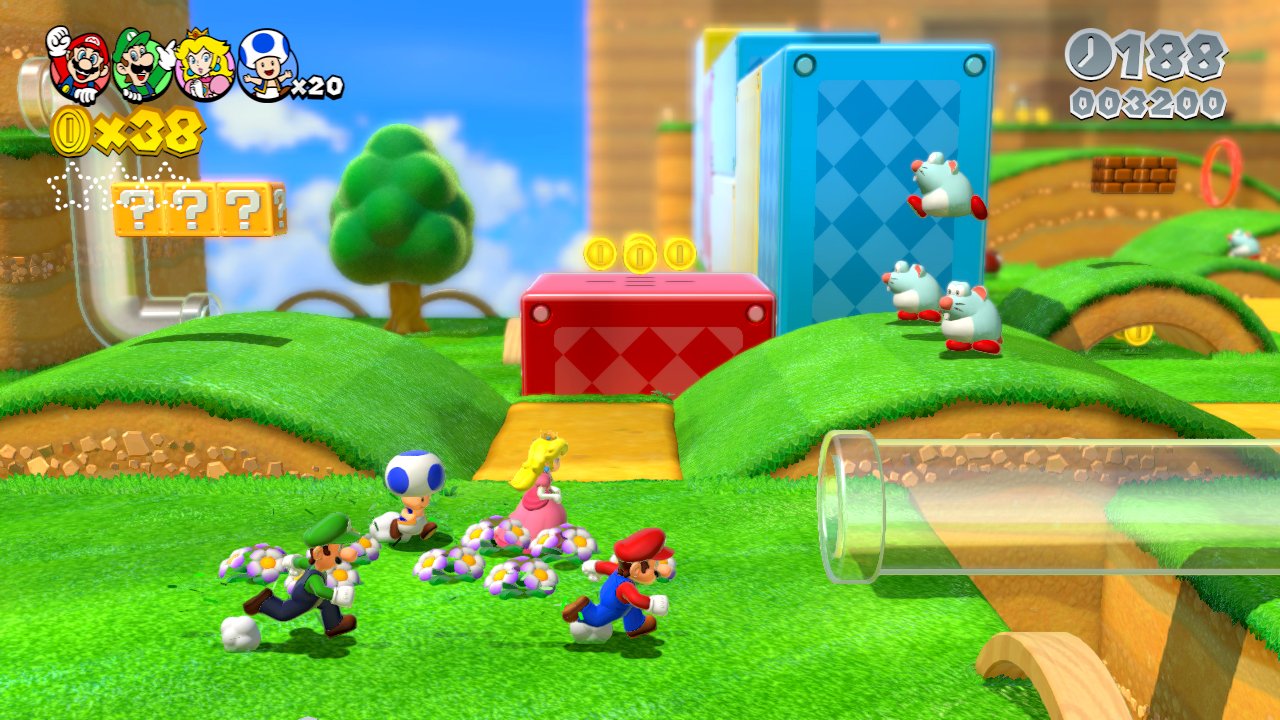
Spyro the Dragon was also very technically impressive for the time. Instead of using fog to hide unloaded geometry, Spyro cleverly used a system called LOD (Level of Detail) which renders far away objects with simpler textures and smaller polygon counts. Here is a video about how the effect works if you're interested. Today, the effect is a little rough around the edges and more noticeable than it should be (especially in Spyro 1). It's still really impressive and I think that the effect actually looks quite nice in screenshots.
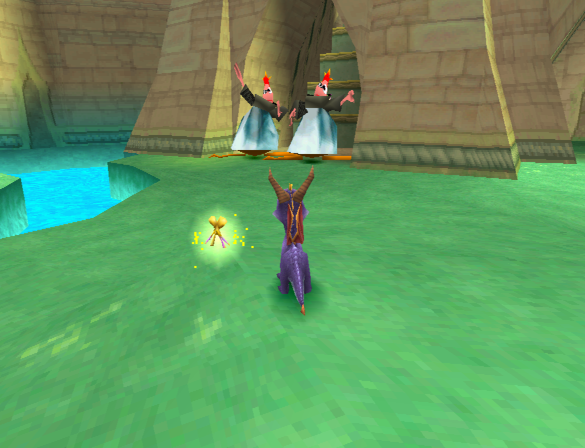
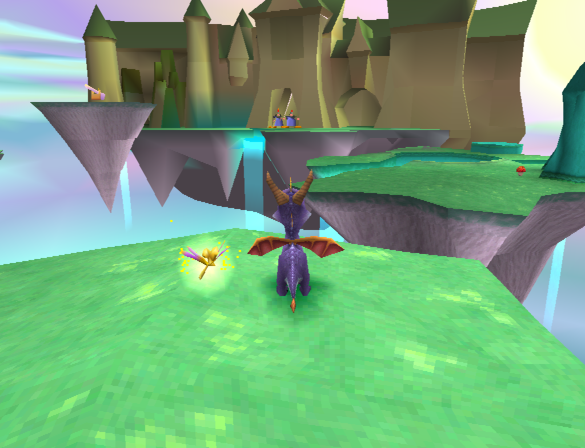
All this adds up to a game that is still nice to look at over 20 years later. If you ask me, this game looks better than most games released nowadays including its own remake.
Spyro's gameplay is similarly inviting. The game is a really nice challenge for casual players. Experienced players probably won't find the game particularly challenging, but will still enjoy the game's mechanics. Charging, gliding, torching enemies, and picking up gems always feels really satisfying. When compared to its sequels Spyro 1 is often criticized for its lack of gameplay variety, but I never really minded it all that much. The act of just moving about the level feels fun, even without any enemies. Insomniac themselves, the game's developers, felt that this was important. They allegedly had a copy of Super Mario 64 in their offices and would often just have Mario run around in circles. Getting to move around the 3D world was its own reward.
In fact, that's something I really admire about Spyro the Dragon. The core gameplay is really, really solid and (almost) nothing ever gets in its way. Spyro handles difficulty really well because it always ties back to the core gameplay. The first couple of levels have very easy-to-kill enemies and very basic platforming challenges with nearly no 'death fields'. It never gets harder than needing to know which attack is appropriate for each enemy (which the game tells you many times) or having to glide over a pit in Town Square.
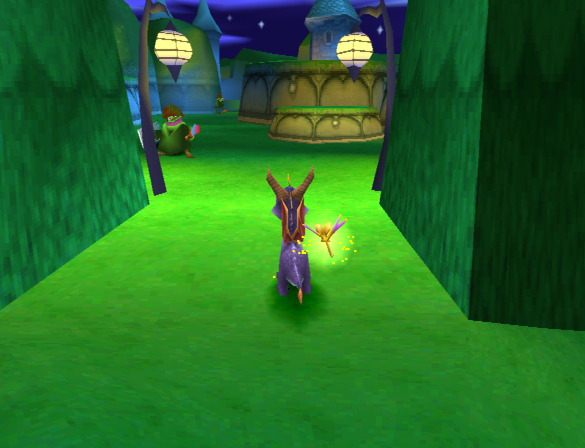
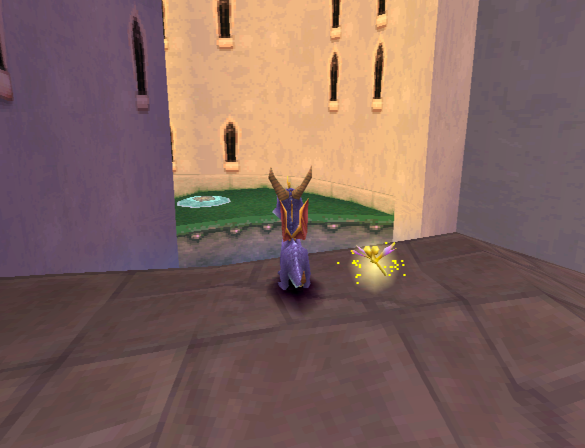
This becomes slightly more difficult in some of the side-paths. Town Square has a hidden area that requires a precise glide to get to, at which point you need to chase a thief near a cliff and through a tight corridor. The game's generous completion requirements mean that you can skip out on a lot of this content, or come back to it later when you've gotten more comfortable with the controls. Interestingly, Spyro the Dragon is one of the few games I've played (perhaps the only collectathon I've played) where you are never required to visit a level more than once. Experienced and returning players will be able to get all of the collectibles on their first visit. I really love this. It feels like a reward for learning the game; the more time you spend getting accustomed to the controls and levels, the more stream-lined your concurrent play-throughs will be.
Levels get more difficult as the game progresses without ever straying away from the core challenge of platforming, collecting, and basic combat. Later levels feature more death fields such as bottomless pits or toxic liquids. The first home world is comprised of smooth, flat terrain with the only possible way to die being a small puddle of water near an entrance to a hidden level. By the time you get to Dream Weavers, the final home world, you have to navigate between small, floating islands over a bottomless pit. Enemies also get more difficult to fight, having faster attacks or throwing projectiles. Some enemies also have special conditions for being killed, like needing to push Gnorcs off the ledge in Ice Cavern or needing to kill giant spiders in High Caves with the super-flame power-up.

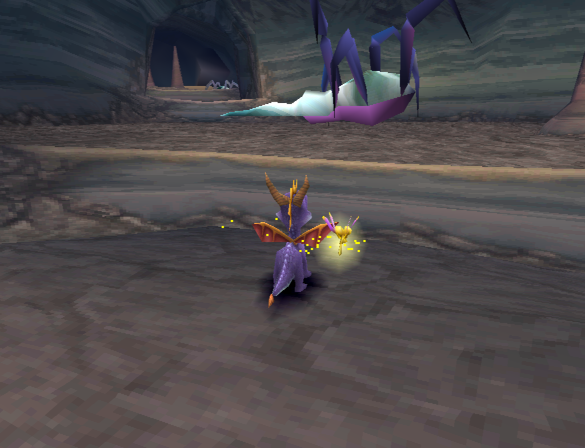
My favorite gimmicks are from Dream Weavers and come in the form of the fools. In Dark Passage you need to attack the fools to make the enemies less threatening. In Jacques you need to attack them to make platforms appear. This is why I was never comfortable with the drive for challenge and gameplay variety in the sequels. In my eyes, both games have difficulty handling what the first game did flawlessly.
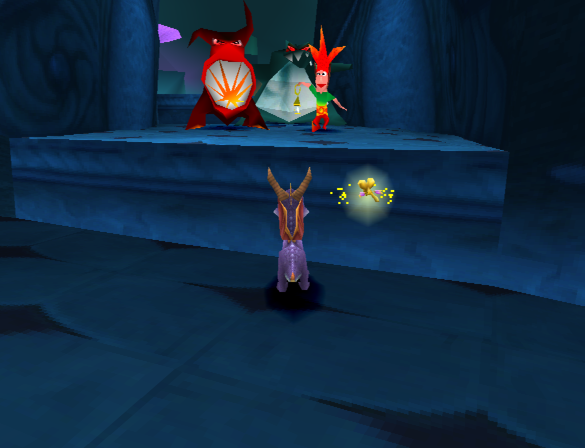
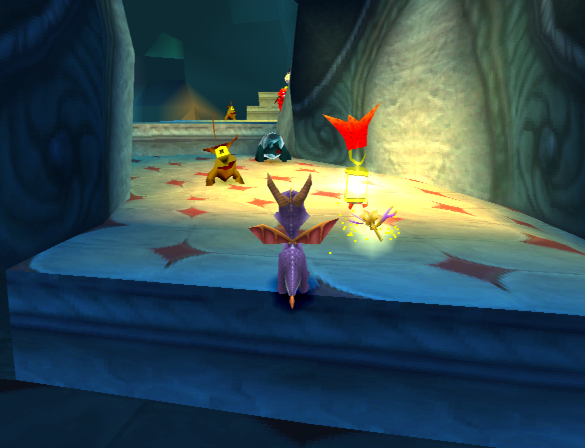
Of course, this game isn't perfect. It is damn close, but there are a few issues. The bosses are incredibly underwhelming. Sometimes it is just unclear when to attack them. Every time I watch someone play this game they always get hit by Doctor Shemp. Spyro doesn't typically rely on this kind of trial and error. Other times the bosses are pitifully easy; I don't think I've ever gotten hit by Blowhard in the 10+ years I've been playing this game. The difficulty curve is generally pretty smooth but there are some bumps along the way. I think Toasty and Misty Bog are both much harder than expected for where they are in the game. Misty Bog in particular is probably the hardest level in the game due almost entirely to the dreaded attack frogs and the lack of health pick-ups.
Some oddities in the controls also make the game a little awkward to come back to. Spyro 1 is noticeably more sluggish than its sequels or its remake. It's pretty minor and only really noticeable to experienced players. It may make the learning curve ever-so-slightly steeper for casual players. The camera is also controlled with the triggers which is difficult to get used to. This was the industry standard at this point so I can't really hold it against them; the right analog stick didn't really catch on until midway into the PS2's life. Spyro also has a strange roll move which you can get by pressing one of the bumpers. I don't have much to even say about it… it just felt awkward to not mention it. Personally, I never found instances where it was useful. In fact, I often forgot that it existed. The developers must have felt the same since they omitted it from the sequels and it wasn't a huge loss.
I said that the game never strays from its core mechanics… but there actually is an exception. Spyro 1's only additional gameplay style comes in the form of the Flight levels, which in later games are called Speedways. I think that, for some players, these can add some much-needed gameplay variety, but to others they can be an annoyance. Nowadays I don't really have strong feelings about them one way or the other as I've played this game enough that I find them very easy, but they were definitely a difficult obstacle to overcome when I first attempted to complete the game at 100%. I find that these vary wildly in difficulty and don't follow the smooth curve of difficulty present in the rest of the game.
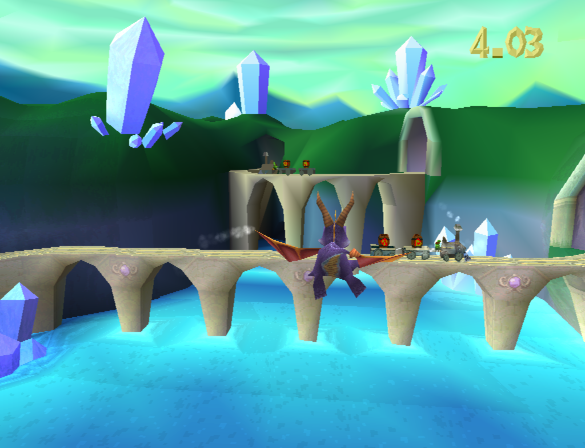
Thankfully, unless you're going for 100%, this content is optional. Spyro 1's completion requirements are very generous. Progression between the home worlds is gated by the balloonists, who each require a certain number of collectibles to allow you to pass. These can be dragons, gems, or eggs. Most of the time they ask for approximately half of a certain collectible available to you at that point. The balloonist in Magic Crafters, the third home world, asks you for 5 eggs which is a little less than half the total amount available to you at that time (and the whole game for that matter since they stop appearing after that home world for some reason). The balloonist in Dream Weavers asks you for 6000 gems, a little more than half of the total available gems. The one glaring exception is Beast Makers, the fourth home world, which asks you to rescue 50 dragons. Keep in mind that there are only 58 available to you up to that point. In fact, even if you get every dragon in the other three home worlds you only have 48. I have to imagine that this probably stumped a lot of casual players.
Again, it isn't perfect. Nothing is, but Spyro comes really close. I really believe it is a game that almost anyone can play and enjoy. The gameplay is simple enough for grandma yet intricate enough for the most hardcore players. The game's presentation is also excellent. The worlds are all detailed and colorful, technically impressive at the time and still artistically impressive to this day. The character designs are so fun and the dragon dialogue is… it's pretty bad, actually, I have nothing to say about it.
…I almost forgot! No review of Spyro the Dragon would be complete without mentioning its iconic music. Spyro's soundtrack was composed by the legendary Stewart Copeland, the founding member of The Police. I made a video about that band if you're interested. Not to brag, but I think the video holds up pretty well. There are some little nitpicks I have with it, but this article isn't really the place for them, so I'm just going to carry on. It's difficult to convey how great the music of Spyro the Dragon is. This video does a pretty good job explaining the technical aspects of the music, if you're interested. Bass, guitar, percussion, organ, and some more obscure instruments come together to form a really fun, recognizable sound. There are too many great songs to mention. If I mention one, I'll have to mention 20 more. The soundtrack also makes very heavy use of leitmotif, but it never gets annoying. In fact, I actually like it quite a bit. Even as the levels get more difficult, that little melody is always there to comfort you. As Copeland explains in this old interview with PlayStation Underground as well as this more recent interview before the creation of the Reignited Trilogy, he would play the levels and then get a feel for the music. He actually shows off the process in the PlayStation Underground interview and makes it look totally effortless.
Oh, yeah! That reminds me. Copeland recently released an album of remastered tracks from the original trilogy, fittingly just called Spyro. It also features alternate takes and cut tracks. I think the remaster is serviceable enough, although I do think some tracks sounded better before. For the original game the music needed to be compressed and down-mixed to mono, likely to prevent lag, so the stereo of the remasters will sound really fresh, especially with a nice pair of headphones. Interestingly enough, prototypes of the game feature uncompressed music and there are differences between these uncompressed tracks and Copeland's remasters. Compare the sound of the original stereo mix of Ice Cavern to its remaster.
Interesting to note is that the music of Spyro the Dragon does not actually loop. The songs actually fade out slowly before repeating. Something else that's interesting is, when idle in a level for long enough, you might hear some alternate tracks play. It's possible that this is just a bug, but I think it's a cool feature. If you happen to get stuck in a level for too long you don't have to hear the same song over and over again. In my most recent play-through I never spent enough time in a level to hear this.
To end off the discussion of Spyro 1, if there's one thing I really admire about this game specifically, it is its polish. The little extra stuff that subtly nudges the game into the greatest-of-all-time tier. Little details like the portals showing the sky box of the level you're about to enter, all the optional interactions like lighting the fires in Dark Hollow or smacking the lanterns in Dark Passage. Spyro 1 in particular shows more polish than its sequels. I love the 3D letters of the HUD and the seamless level transitions.
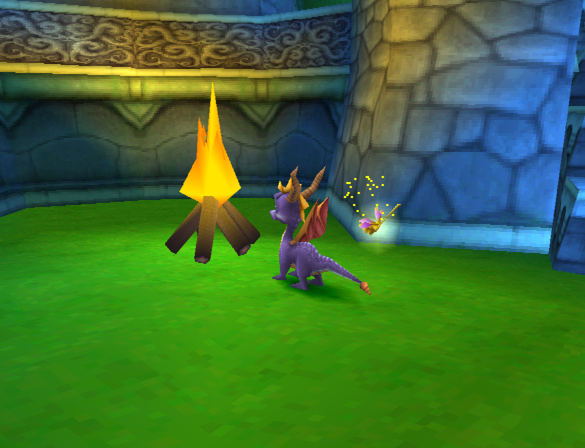

Oh, and the entire Spyro trilogy have amazing sound effects. My friends and I recently played a game where we took all the sound effects from Spyro 1 and had to guess where they played in the game. We got a surprising amount of them correct.
Spyro the Dragon is a certified classic that I'll never get tired of playing or discussing. This is a must-play for any fan of collectathons or 3D platformers. I also believe it's an historically important game. I think any fan of the medium should play it.
Spyro 2: Ripto's Rage (1999)
I expected to enjoy Spyro 2: Ripto's Rage when playing it again and I still ended up being surprised at how much fun I had. The reason for my apprehension boils down to one concept: gameplay variety. The spectre of gameplay variety loomed over many games of this era like some kind of ancient Greek tragedy. It was all the rage to make your game bigger, louder, and better than the last by trying to offer up as many different gameplay styles as one could program. Spyro 2 and 3 both handle this differently and to varying degrees of success, so I'll be making frequent comparisons between the two.
Most of what I loved about Spyro the Dragon is still on display here and, in some capacity, in greater force. Charging, flaming, and gliding are back with a vengeance. In the first game Spyro would do a really wimpy little hop if you tried to jump while charging, while in Spyro 2 he does a nice, big leap that makes charging around levels much more convenient. My favorite addition to Spyro's move set comes in the form of the hover. In the first game the player would press the triangle button to make Spyro descend in mid-flight, which would cause him to abruptly halt all his forward momentum and flop on the ground. Spyro 2 replaces this motion with the new hover move, which makes him flutter in the air a bit. The player still has control over Spyro during this little movement. It's a really nice little move that adds so much to the game. Some of the more challenging glides can be made much easier by the hover. This also allows them to put in really difficult glides which require perfect spacing and proper use of the hover. It honestly feels a little weird going back to the first game after playing Spyro 2 because of this move.
Spyro 2 also features a few more additions to his move set. Spyro unlocks the ability to swim, climb on walls, and do a ground-pound move called the headbash as the game progresses. The only one of these three that I really enjoyed was swimming. It's the only power-up that makes you look at levels a different way and is seamlessly integrated into gameplay. The level Aquaria Towers has you navigate on foot to find buttons that raise the water level. When the water level is raised it lets you explore new areas of the world. Eventually, you fill the entire world up with water and you get to visit this really cool optional area above the level.
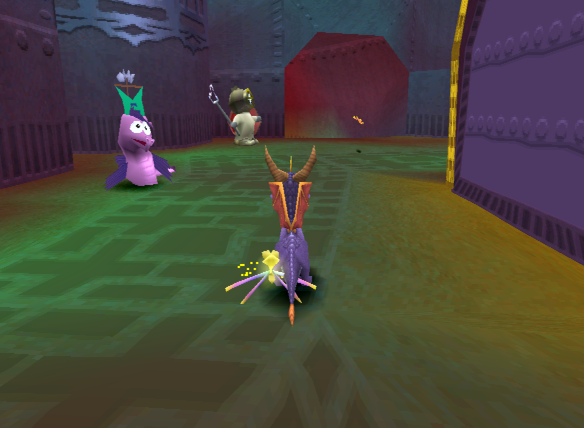
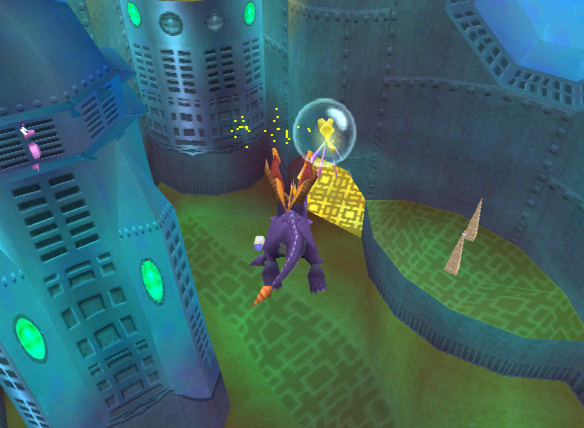
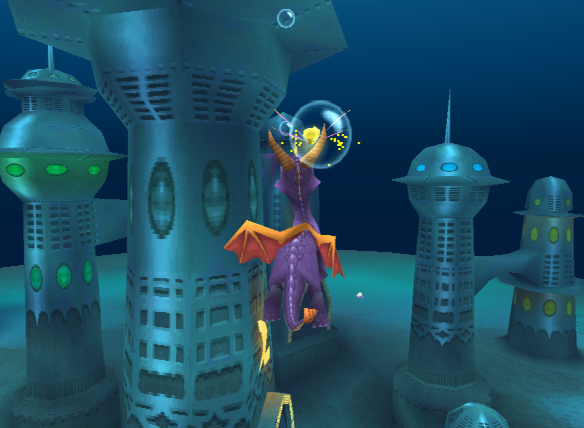
Climbing walls really doesn't add as much as you would think. It ends up just being an annoying way to gate off certain areas that they want you to come back to later. Plus, it really just feels like something I should be able to do by default. Same could be said of the headbash move which is so sparingly used I often forget it exists. These two power-ups end up serving a very annoying function: necessitating backtracking. In Glimmer, the first level, there is a ladder that blocks off some gems and one of the orb challenges. You don't get the ability to climb until the second of the three home worlds. There are a few other instances of levels requiring power-ups found in later worlds and I found them all tedious. This likely won't matter much to casual players, but as a more experienced player I just find it a bit of an annoyance. I really liked how you could avoid backtracking in the first game. Spyro 2 could have done something similar by carefully placing the power-ups so that an experienced player could create a route around the required gems. Unfortunately, one cannot avoid backtracking if they wish to get everything.
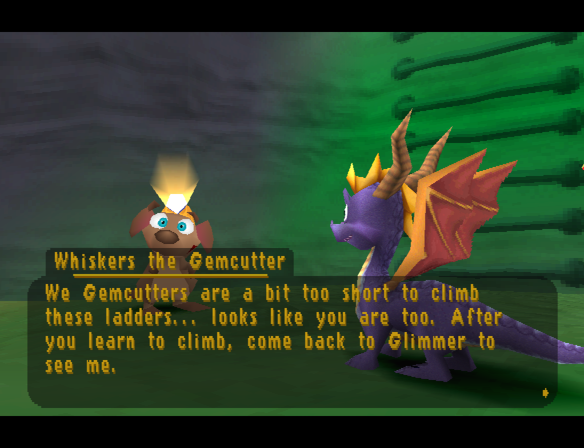
Oh, and before you say it: Yes, I am aware that there are ways to skirt around the required backtracking, but those methods use glitches and exploits that weren't intended by the developers. If I'm playing the game the way it's meant to be played, I have to backtrack. Besides, Gulp skip is way too hard.
There is one more move in Spyro's arsenal: If the player holds down all four shoulder buttons, Sparx will point to the nearest gem. This is a life-saver for completionists. I've played Spyro the Dragon enough that I happen to know where everything is, but nothing was more annoying than being just a few gems short of 100%. This was a problem for many collectathons of that era and it was a problem that not all players would encounter. The gem finder is a really genius move. It just cuts the fat of a long play-through. Casual players may even find it helpful if they're a few gems shy of the requirement. Honestly, my only complaint is that the game never tells you about it. It's incredibly useful and not the kind of thing I would ever spontaneously think to do. It is mentioned in the game's manual to be fair.

Ripto's Rage features a few other quality-of-life changes. The camera is still controlled with the trigger buttons, but I find it much less cumbersome to work with. The camera moves faster, it gets stuck far less often, and the player can center the camera behind Spyro by pressing both trigger buttons. It doesn't afford the same level of comfort as the right analog stick, but for the time this was a good compromise. Sparx's gem pick-up range has seen a considerable improvement. Sparx will now track gems vertically. This is a lot more useful than you expect it to be.
For as much as I may nitpick this game, I still really like it. That is because, among other things, the core gameplay is just really strong. Picking up gems, charging, torching enemies, and exploring the world is still an absolute treat.
The main collectibles of Spyro 2 are gems, talismans, and orbs. The game is now constantly checking you for gems. Moneybags will open bridges, unlock entire levels, and give you power-ups for a "small fee." In my testing he never asked for more than half of what was available to me. I don't mind buying the power-ups. It's satisfying to earn up enough gems to learn a new ability, even if actually using those abilities isn't always so exciting. In theory I'm much less okay with him gating off levels, but in practice I don't really mind since I enjoy grabbing gems anyway. Plus, it's only even an issue to begin with because of the second collectible: the talismans. Talismans are awarded for simply reaching the end of the level. There's one for each of the first 14 worlds and they are all required to progress the game.
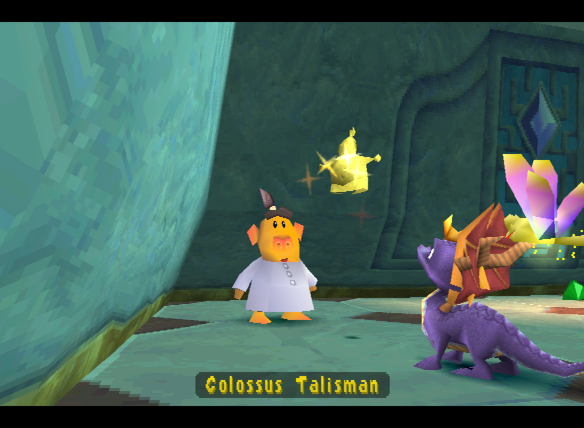
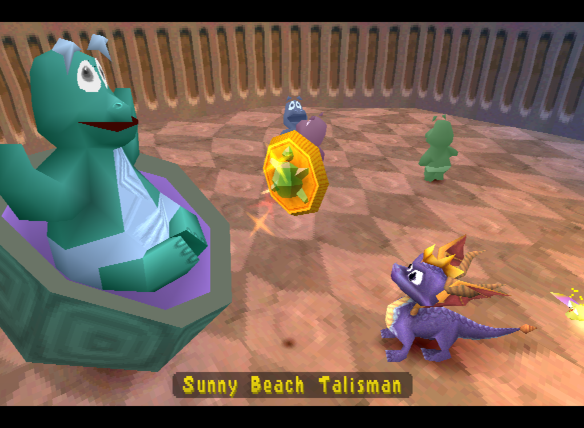
Again, I don't really mind this in practice, but I think it's a very unnecessary and potentially annoying restriction. I miss the freedom that Spyro 1 afforded and I don't see anything majorly wrong with the way that game handled its completion requirements. You could play the game at your own pace. If you were diligent in the early levels, you were potentially rewarded by getting to avoid some of the more challenging ones. Of course, you could also just voluntarily choose to engage this content anyway, as I did. Maybe you'd like to come back to it later after you've beaten the game and are ready for a real challenge. The point is that you have a lot of control over the order you play levels in. If I were to remake this game I would have replaced the talismans with the third collectible: orbs.
I'll have more to say about orbs soon enough. The short version is that they are extra challenges and mini-games scattered throughout the levels. Most levels tend to have around three or four of them. The game only has two mandatory orb checks. One is a door in the second home world, Autumn Plains, that requires 8 orbs to open. The second check is the door to the final boss, which requires a whopping 40 orbs to open. Spyro 2 does strongly suggest that you collect orbs and gates off optional levels with orb requirements. Still, I have to imagine that the 40 orb requirement came as quite a shock to casual players. To reiterate, I personally don't really mind this in practice. If talismans were replaced by orbs this would solve a lot of problems. Levels and bosses would be gated off by a certain number of orbs, which would incentivize players to go after them while still giving them the freedom to avoid certain levels. They might not want to pay Moneybags to access a level but may feel motivated to do so if they're short on orbs.
Want to know the craziest part? Spyro 2 does more or less exactly what I'm describing in the final home world, Winter Tundra, which is my favorite by far. If you've gotten every orb in the first two home worlds, you can skip ahead to fight Ripto. I find it confusing that it took them two home worlds to figure it out.
To me, an experienced player, this is a minor flaw. I'm not sure how this will affect casual players and if they'll be more or less bothered than I was. If you've got an interesting take on this then let me know via E-Mail or Matrix.
The orb challenges are, in theory, a very nice addition to the game. In practice I find that I merely don't mind most of them. That sounds harsher than I would like, but I really can't think of a more appropriate description of my feelings towards them. Orb challenges are a potentially interesting way to reinterpret the mechanics of the game. Spyro 2 boasts puzzles, treasure hunts, escort missions, stealth missions, shooting galleries, and the most beloved of all: hockey. The critic in me is impressed that they were able to squeeze so much out of simple mechanics. I can tell they had a lot of fun making them. Actually playing them is a different story. As I said, I don't mind most of them.
My favorite orb challenges were always the ones that tied into the core challenge: platforming and collecting. Finding the hidden orbs in Autumn Plains felt really satisfying. There's a really great challenge in Zephyr which has you planting seeds to grow platforms. I also liked all the orbs in Skelos Badlands. The lava lizard chase was tough as nails; it's so satisfying when you get that perfect run. The other challenge has you collecting bones, forcing you to look in hard-to-reach places. You can start working at the challenge as soon as you load into the level. The reward you get is pretty nice (and I'm not just talking about the orb).
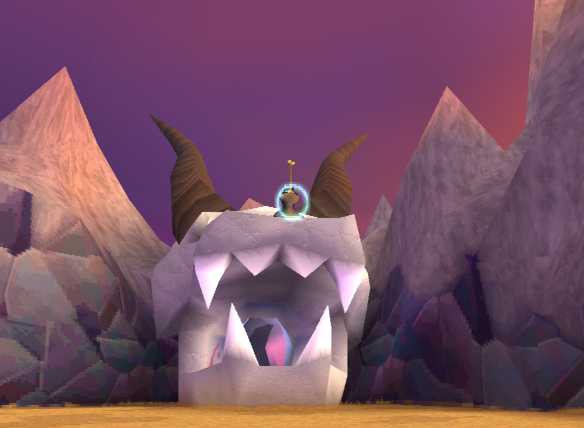

There's another great challenge in Cloud Temples which has you use a unique ice-breath power-up to freeze enemies and turn them into platforms. Ideally, all of Spyro 2's orb challenges would have mechanics like this. It feels like that was their intention. I remember hearing somewhere that the orb challenges were introduced because Insomniac wanted to shed the label of Spyro being a 'kiddie' game. I'm surprised that this is what they came up with, since more often than not I found the orb challenges to be tedious and way too simple. I think the crescendo of this are the puzzles in Idol Springs which I hesitate to even call gameplay. Two of the puzzles have you hopping on colored stones and one has you sit in one spot and slowly wait for fish of the correct color to pop out of the water. Thankfully, this is just one orb of 64. Most aren't anywhere near this bland, yet most aren't particularly breath-taking either. Spyro 2's orb challenges often capture the essence of popping bubble wrap: Simple tasks that are mildly satisfying and never too taxing; Slamming trees to make monkeys fall into a barrel, deflecting bombs at an ox while skating (this game is weird), or firing rocks at simple, slow-moving targets. Maybe some find this enjoyable, perhaps it has a therapeutic effect for them, I find that it struggles to hold my attention for very long.
Thankfully, Spyro's core gameplay is really solid and it more than makes up for the orbs. This is why I will repeat myself and say that I don't mind these challenges. I don't think I would go so far as to call them padding, but they do feel largely unnecessary. I'm afraid I'm coming off as much more frustrated than I actually am. I think Spyro 2: Ripto's Rage is a flawed game, but I would still say it's one of the greatest collectathons ever made.
That is due in no small part to the character of Spyro 2. This game is oozing with personality and charm. I love so many of the NPCs in this game that I can't possibly be expected to choose a favorite. I just love how, if you listen closely, you can hear the same three or four voice actors for everyone. I know that's a weird thing to compliment, but it makes me think of the small, ambitious 20-somethings that made this game. This was made by people that clearly cared and had way too much fun writing the dialogue. The conclusion to the seed-planting challenge in Zephyr is one of my favorite things in any video game ever.
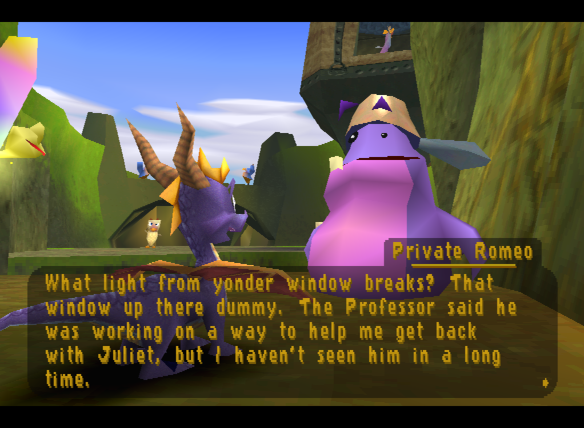
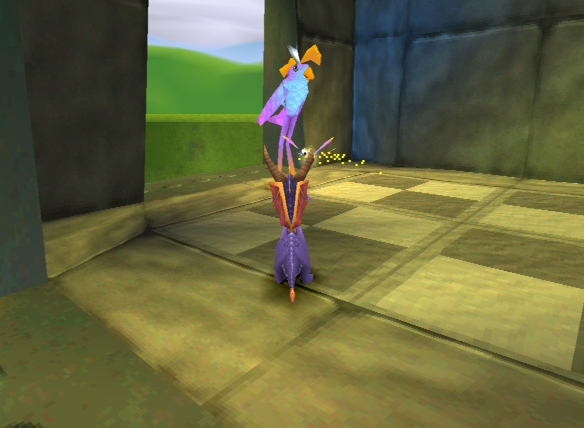
Another detail I always found funny was how the electrolls from the level Hurricos are just Spongebob. Seriously. Spyro 2 and Spongebob Squarepants were both being produced around the same time. Tom Kenny, who also plays Spyro, probably just thought to reuse that cartoon voice he was doing. After all, why wouldn't he? He didn't know how mega-successful Spongebob would become.
I also love the story cutscenes. I can't really express what makes them great without just telling you to go play the game. They are just pure, concentrated wholesome-juice. The level intros and outros are also cute. These were cut from Spyro 3. I appreciated the effort, but it wasn't a huge loss. I always thought the pacing of these cutscenes was a little weird. As an example, I never understood why, in the Colossus intro cutscene, the monk just stares blankly at the screen for a few seconds. Well, as it turns out, these cutscenes were originally going to be narrated by Elora. You can hear this in some of the prototypes for Spyro 2. These cutscenes explain a lot. Ripto's presence in the story cutscenes is really strong, but I always felt that his role in the conflicts of the individual worlds was unclear. Well, Elora clarifies that Ripto was the one starting these conflicts. He sent the water workers to Sunny Beach, he sent the ice wizards to Crystal Glacier, etc.. Her narration sounds a little awkward at times, although I'm not sure if that's just because I'm used to the final versions. Judging by the video, it sounds like not all of it was finished. Maybe they didn't finish the dialogue in time and decided to scrap it at the last second.
If you find this behind-the-scenes information interesting, I'd recommend going to The Cutting Room Floor and reading some of the pages on there. There's a lot of really interesting information about Spyro 2 in particular.
Spyro 2 expresses the most character in its world design. Avalar is a really fun place to explore. The worlds all feel lived in and connected. I always liked the way certain worlds shared enemy types and had similar NPCs. Skelos Badlands and Crystal Glacier have a similar aesthetic and a yin-yang duality of hot and cold. One of the coolest examples is how the levels Zephyr and Breeze Harbor are at war with one another. Your allies in one level become the enemies in the other. Originally, these connections were going to be more overt. Early prototypes reveal that all the levels except Hurricos and Glimmer had a twin. Sunny Beach was originally Aquaria Beach, Crystal Glacier was originally Skelos Glacier, Cloud Temples was originally Mystic City, etc..
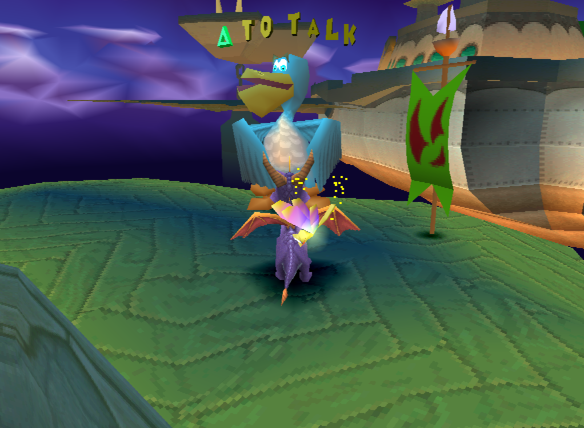
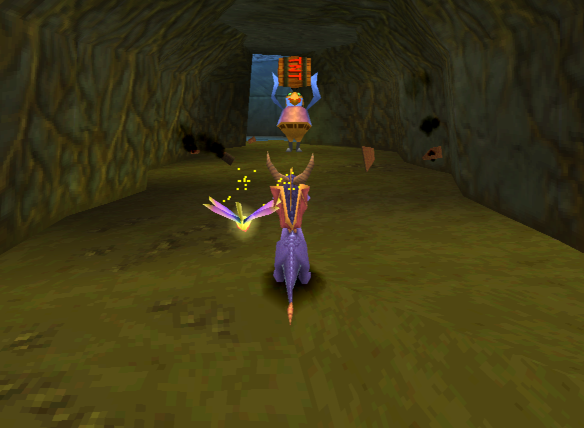
I'm fine with collecting the orbs as an excuse to meet all of these fun characters. I can see why so many people consider Spyro 2 their favorite, even if I personally don't agree.
Ripto's Rage probably has my least favorite soundtrack of the original trilogy, which is impressive since this soundtrack is really good. I really like how each game has a unique style of music. The music of Spyro 2 makes good use of some beautiful, radiant soundscapes. You can prominently hear them in the home world themes, but they also appear in the background of some of the level themes, such as Hurricos and Idol Springs. Spyro 2 also uses samples to a really good effect. Copeland combines some weird, tribal flute sounds with these synthesized drum loops and then layers it with all the classic Spyro instruments. Great examples of this are Scorch and Cloud Temples. I remember really disliking Colossus when I first heard it, but it's really grown on me during my most recent play-through. The way the organ kicks in at the very end is one of the most satisfying things I've ever listened to.
Last thing I'll mention… since I don't really know where to put this: I'm not crazy about the bosses in this game. The presentation is great and I think they're really well designed, it just doesn't appeal to me all that much. I think Ripto's Rage has the best boss fights in the series… which is unfortunately not a high bar. Of all the criticisms I've levied at Spyro 2 I'd be most willing to accept this as "oh, you're just being weird." I'm always stressed out by the lack of checkpoints. I think I'm bothered by it more than most.
Spyro 2: Ripto's Rage is, despite all of its flaws, a fantastic little slice of gaming history that is worth revisiting 20+ years after its release. It's more than just solid programming (which the game has in spades); it is an honest labor of love.
Spyro: Year of the Dragon (2000)
Spyro: Year of the Dragon represents both the best and the worst of the original trilogy. The short answer is that it has high peaks and deep valleys. In other words the good stuff is really good, yet the bad stuff is really bad. I think the good more than makes up for the bad; there are just a few little bad moments that hurt the experience for me. If I had to mathematically quantify the amount of fun I had, I would probably say that I had more fun with Spyro 3 than with Spyro 2, but I don't feel comfortable saying that. I'm the kind of person that tends to be annoyed by little things like this. I tend to perceive a loss as being greater than an equal gain (which, as I understand, is not abnormal). If I get kissed 100 times and then slapped once, I will tend to remember the slap. Spyro 3's eggs are generally more fun to collect than Spyro 2's orbs, yet the worst eggs are far more irritating than anything Spyro 2 could dish out.
When it comes to actually quantifying this I initially had some trouble. Eventually I decided to split missions into three groups:
- Missions that build upon the core challenge of the game, i.e. platforming and collecting.
- Missions that repurpose the game's core mechanics for a different kind of challenge, such as escort missions, puzzles, or mini-games. The mini-game classification is ultimately subjective on my part.
- Missions that use a completely unique control scheme and gameplay style.
You could probably guess that I prefer the first category. In the first Spyro game, all the collectibles fall under the first category with the exception of the Flight levels which fall under the third. One could argue that the bosses fall under the second. Spyro 2's orbs are near evenly split between the first two categories. Occasionally Spyro 2 had orbs of the third category. There are few enough of them that I can list them all now: riding a manta ray in Aquaria Towers, riding a trolley in Breeze Harbor, and all the Speedways. Just because an orb isn't in the first category doesn't automatically make it bad and just because it's in the first doesn't automatically make it good. This is a very general way to observe Insomniac's approach to mission design and how it changed throughout the trilogy.
Year of the Dragon has more eggs in the first category and less in the second… yet also many, many, many eggs in the third category. Spyro 3 nearly overdoses on additional gameplay styles. I remember hearing somewhere that during Spyro 3's development Insomniac seldom said “no” to whatever somebody on the team wanted to include. I'm not sure if I'm remembering that correctly, but I feel like it applies rather well to Spyro 3. To that end Spyro 3 has skateboarding, racing, shooting galleries, first- and third-person shooting, plenty of vehicles, top-down shooting, and the most beloved of all: boxing.

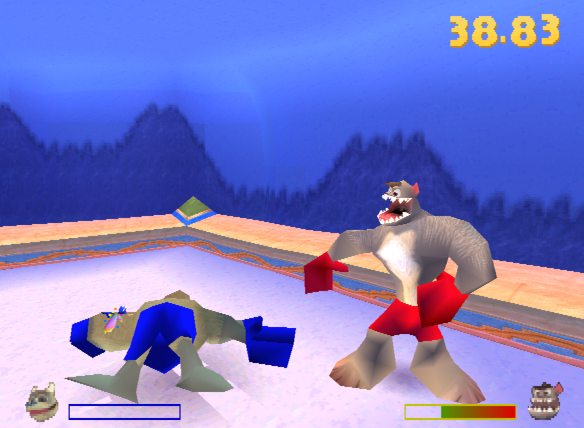
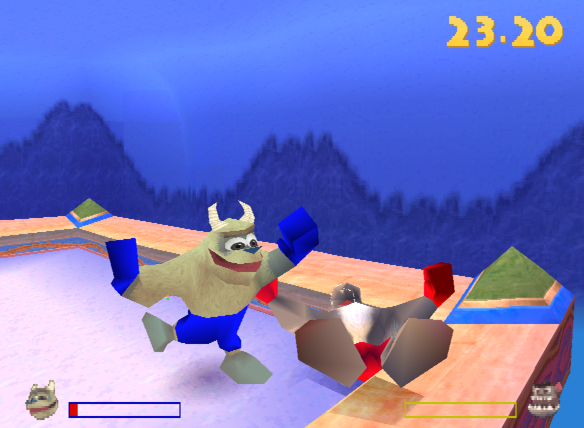
Year of the Dragon features five additional playable characters. Technically six, but all Hunter really does is pilot around vehicles in the Speedways. Two of the new characters, Sheila and Bentley, have controls and gameplay relatively similar to Spyro's. The remaining three characters, Sgt. Byrd, Agent 9, and Sparx, each have totally unique controls and gameplay. This is especially true of Sparx, who was probably my least favorite character to play.

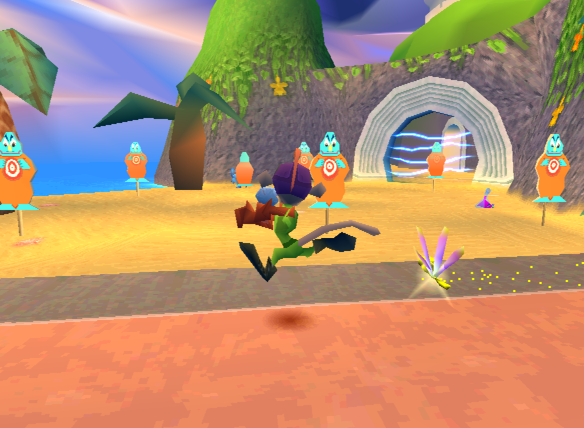
And while they have been generously reduced in number, Spyro 3 does occasionally see the kind of mini-game mission design I criticized Spyro 2 for. To that end the game has escort missions, whack-a-mole, and the return of the dreaded hockey.
There is a unique dilemma that critics face when addressing content like this. With only a few exceptions, each egg in Spyro 3 is potentially optional. There are 147 eggs available before the final boss, which requires 100 eggs to fight. 19 of them are not optional as they are obtained at various points in the story. Really, you only need 81 of 128. Keep in mind that some of the remaining 128 eggs are in stupidly obvious positions that you would have to be going out of your way to avoid. You can complete Spyro: Year of the Dragon while hardly ever engaging the extra gameplay styles (you can't avoid them completely).
By the way, Spyro 3 has the same bizarre completion requirements that Spyro 2 had, i.e. needing to reach the end of every level except for those in the final home world (this is where most of the required eggs come from). Spyro 3 at least does a better job of checking your egg-collecting progress, so the final egg requirement isn't as much of a surprise. It didn't bother me all that much in Spyro 2 and it's even less offensive here.
I personally always like to go for the max completion rate in games like this. Also, I think that's necessary for me to do if I want to properly analyze the game. If Insomniac deemed the act of getting 100% unimportant, they wouldn't have wasted precious development time on the huge bonus world, which is only accessible after getting all the eggs and gems. At the same time, I must also acknowledge that not everyone is going to feel the same way. If ever I'm complaining about some particular mission, someone could always just say “then don't play that mission.” Obviously I don't think it's fair to disregard criticism of the content just because it's optional, but if someone isn't bothered by content that they voluntarily chose to not play, I can't really blame them. I believe my criticism is still justified, but their perspective is equally valid.
Sparx's levels are technically optional, but they do allow you to unlock some very useful upgrades. I'm not all that sure why I should have to prove my worth in a top-down shooter to earn an upgrade in a 3D platformer. The upgrades you get are pretty nice. You can unlock a larger gem pick-up range, an extra hit-point, the ability for Sparx to automatically break crates, fast-travel, and, annoyingly, the gem finder. Yes, the same gem finder that was available from the start in Spyro 2. I don't like that the game now treats it like an upgrade that needs to be unlocked. I just took for granted that it was a really nice quality-of-life change. On my most recent play-through I left each level of the first two home worlds with five or so gems missing.
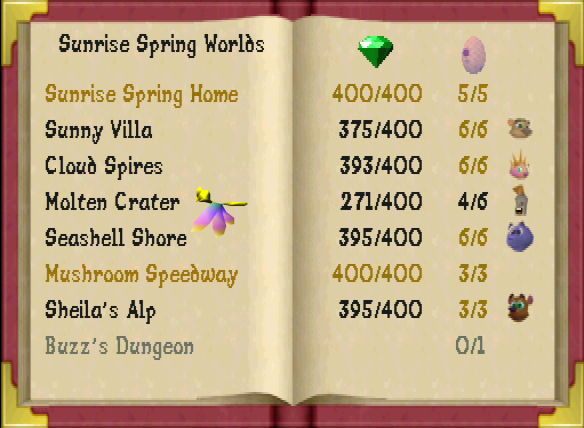
This always bothered me a lot. I guess I wasn't the only one since the
remake just gives it to you by default in all three games. Funnily enough,
Insomniac themselves must have felt the same since there's actually a cheat
code to unlock the gem finder. A cheat code that I just didn't know about
until after I already unlocked it in my most recent play-through. Just
pause the game and press R1, R2, L2, L1, R1, R2, L2, L1, circle, circle,
circle NTSC-U version 1.0 has a different code: right, right,
left, left, right, right, left, left, circle, circle, circle
Oh, yeah, I should probably mention that, shouldn't I?
The shakiness of some of Spyro 3's extra gameplay styles isn't for a
lack of effort on their part. Spyro 3 was rather notoriously rushed. The
fact that the game came out as well as it did is honestly miraculous and really
speaks to the incredible talent at Insomniac. Still, the first version of
Year of the Dragon shipped with a few glitches and oversights. The
levels Enchanted Towers, Lost Fleet, Crystal Islands, Haunted Tomb, Dino Mines,
and three of the Speedways re-use music from other levels. The music for
Evening Lake and Sorceress's Lair, the final boss, are present on the disc but
go unused due to a programming oversight. Both erroneously use the first home
world theme (which, in the case of the final boss, is very anti-climactic). One
of the story cutscenes doesn't play, again due to a programming oversight. Most
infamously there are a few eggs which can be rendered permanently unobtainable
due to a glitch. All of this was fixed in the various re-releases. Annoyingly,
version 1.0 is the version that is distributed via the
PlayStation Network. If
you're a cuck that doesn't emulate games determined to play games
via legal means, you'll need to hunt down a copy of NTSC-U version 1.1 and deal
with all the headache that causes, or cope with the inferior version.
I am in no way suggesting that you should just download a copy of NTSC-U version 1.1 and emulate it with DuckStation. Downloading games is illegal, after all.
Back to Sparx, I find his levels particularly annoying. It's a top-down shooter with archaic controls and abnormally loud sound effects. It's also really damn difficult, which goes for a lot of the extra gameplay styles. Those of you that have played this game are now likely shouting at your computer screens about that odious boxing mini-game. There's a problem when it comes to including difficult challenges in a unique gameplay style. Even if the challenge is designed well (which isn't always the case) there's still the lingering sentiment of “I didn't sign up for this.” When I got ready to play the next Spyro game I wasn't prepared to play a first-person shooter or a brutal tank mini-game. If you're not using the core mechanics of the game you should probably avoid exerting too much stress on the player. The remake, to its credit, tried to address this by significantly cutting down the difficulty of these challenges. It didn't always succeed, but we'll get to that later.
I can see the appeal of having challenges like this. A 117% run of Spyro 3 is most definitely not something that anyone can achieve. Fully completing Spyro 3 requires you master a bunch of different mechanics and control schemes. If you're up to it, Insomniac will hit you with everything they've got. What other game allows you to claim mastery over platforming, shooting, and skateboarding? I won't lie, getting that final egg is incredibly satisfying. I think back to all the trials and hardships I faced on my journey and I feel like an absolute Chad for having gotten so far. I'm just not so sure the gratification is worth the frustration. I don't think I would feel any less satisfied if the boxing or first-person shooting was made easier or even nerfed to triviality.

I just feel like I'm being pried away from the core challenge that I really love which, by the way, is incredibly solid in Spyro 3. Platforming and collecting are an absolute joy. Spyro 3 generally boasts stronger level design than Spyro 2. The game's intricate, vertical level design makes better use of Spyro's move set. By the way, Spyro keeps all of his power-ups from Spyro 2.
Outside of the home worlds Spyro 2 seldom ever had orbs lying around levels. Sometimes they were tied to platforming challenges like the difficult glides in Hurricos or finding the bones in Skelos Badlands. Spyro 3 ties more of its eggs to platforming challenges. Each level has six eggs. You'll get one egg by just reaching the end. Typically each level will have one or two more just lying around. The game gives these away freely at first, but puts them in harder to reach areas as the game progresses. The level Frozen Altars has some really good examples of these difficult platforming challenges that are just integrated seamlessly into the level. It reminds me of the way Spyro 1 scattered dragons throughout its levels.
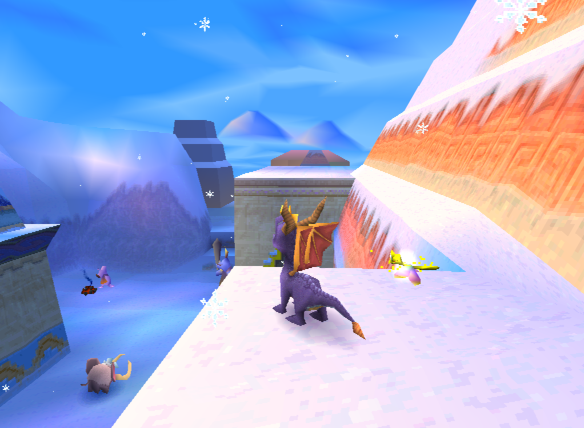
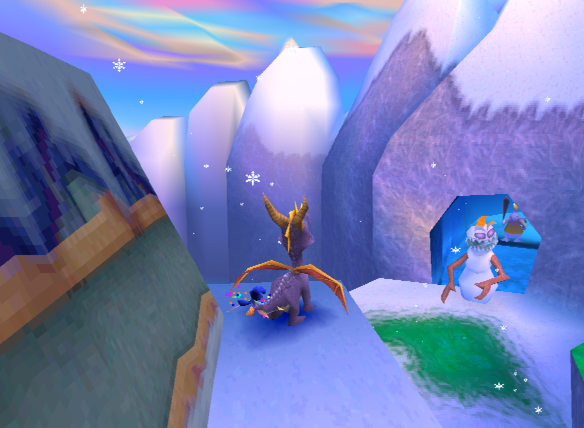
The remaining eggs are isolated behind portals. These contain additional platforming challenges as well as all the extra mini-games and characters that I mentioned before. As you could probably guess, I much prefer this approach to Spyro 2. The levels also feel really varied with lots of unique ways to find the hidden eggs. The level Frozen Altars gives Spyro ice breath which allows him to freeze enemies and NPCs so he can use them as platforms. This is a really fun extension of the orb challenge in Cloud Temples from Spyro 2. The level Icy Peak has you use a cannon to open up whirlwinds that let you explore more parts of the level. The level Lost Fleet has you get a power-up to swim through an acid lake to find a hidden area as well as a hidden alcove containing an egg. Spyro 2 did have good level design like this as well, I just believe it's on greater display here.


I would like to mention a level that I think is really cool in concept. The level Enchanted Towers is a really huge, wide-open area. At first you have to play as Spyro, but eventually you reach a portal that lets you switch to Sgt. Byrd, who can freely fly around the level. He can reach places that Spyro can't. In concept this is really cool and I wish this was done with the other characters. In practice I just find it kind of a pain since Sgt. Byrd's controls felt really bad. He's way too slow to accelerate to his top speed, at which point he moves way too fast. You can press the bumpers to strafe and holding them both down actually makes him move around a lot smoother. It's useful, but it wasn't quite enough to save his levels for me.
All of the Spyro games are visually stunning despite the limited hardware, but Spyro: Year of the Dragon is probably the best-looking game on the PlayStation. They continue to make excellent use of color to create some really iconic, memorable locations. Icy Peak is probably my favorite level. I love the way the warm sky is reflected in the ice and how it complements all the really deep blues. It looks absolutely gorgeous. I also love the sharp, contrasty look of levels like Charmed Ridge and Lost Fleet.
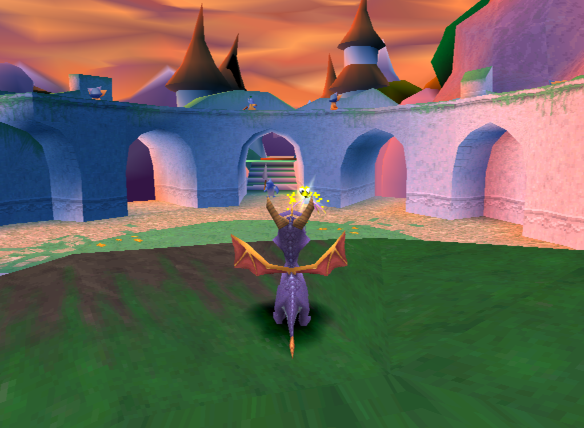
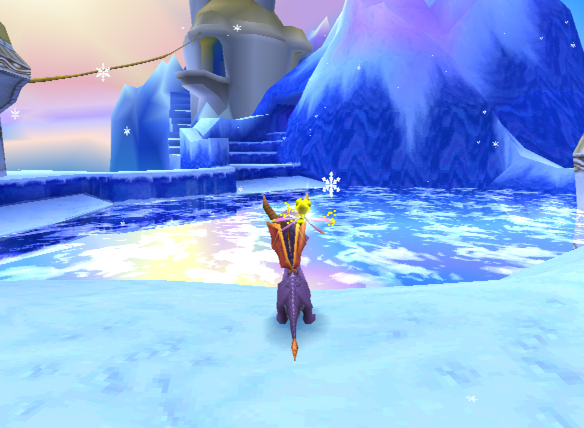
From a technical standpoint Spyro 3 is one of the most remarkable games I've ever played. This game is impressively long for having released more than 20 years ago. There are some instances of repeated content, but not a whole lot more than Spyro 2. The point is that it doesn't feel padded. In fact, I feel like Spyro 3 is the perfect length. When games get longer than this I start to get irritated. This game is a magic trick. I have no idea how Insomniac were able to fit so much content onto the limited space of a PS1 disc. Not to mention that there's a demo for Crash Bash on the disc which, believe it or not, contains nearly the entire game. There's a debug code that was accidentally left in the demo which allows you to access nearly the entire game which somehow fits on the disc that also contains Year of the Dragon. This must have required some NaughtyDog-level hacking to work.
And I can't not mention the fantastic soundtrack of this game. Stewart Copeland and co-composer Ryan Beveridge really hit it out of the park in Spyro 3. This soundtrack has got a really unique style to it. Sometimes it harkens back to Spyro 1 with a whimsical, fairy-tale-like sound on tracks like Charmed Ridge. We continue to see clever use of samples mixed with sharp, synthesized beats like in Bamboo Terrace or Bentley's Outpost. There's also a really cool electronic sound with distorted synthesizers on tracks like Spooky Swamp and Midnight Mountain. The sound is really unique, yet it isn't at all oblivious to the sounds of Spyro 2 and 1. My favorite track in the game is probably Sheila's Alp as well as the remix for Lost Fleet.
I want to make it clear that, for as much complaining as I have done, I really, really love these games. My criticism is my way of showing that I really care. I didn't grow up with them, I only really have memories of Spyro 1, but I still think they're really special. They're an extremely important part of gaming history and… they're just damn good fun. These games have been around for over 20 years, I've been playing them on-and-off for about 10. I'm probably going to continue to revisit these games for the foreseeable future. I could not recommend them enough.
Spyro: Reignited Trilogy (2018)
In the past, I have completed all three games in Spyro: Reignited Trilogy in full. I had intended to do it again for this review but just could not motivate myself to do so. That should probably tell you what I think. I was able to fully complete Spyro 1 without much trouble, but about halfway through Spyro 2 I just gave up. It's not like the game was terrible. After all, I was able to fully complete the game back when it first came out. I just couldn't motivate myself to do it more than once.
I'm not a fan of remakes at all. As I hope to have demonstrated to you, I think the old games are just fine the way they are. No, they're not perfect, but was a remake really necessary? I think if there's an argument to be made in favor of remakes, it's that bad games are more deserving of remakes than good ones. That discussion could be its own article.
Even if this remake was really well made (which it isn't) I would still probably find myself siding with the originals. There's this great expression: “Art is never finished, it is only abandoned.” I look at the games like an interactive photograph, a little captured moment in time. Playing these old games is like time travelling back to a time when games were simpler (and quite frankly better). I really don't like the idea of new people that had nothing to do with the original work coming in and "improving" it. I don't even think I'd want the original developers to remake it. They have changed as people. Would the Insomniac of 2022 have the monks in Colossus make goofy chanting sounds? Would they have designed a turban-wearing character named Bombo? Would they have given guns to the gnorcs in Twilight Harbor? I'd rather not find out.
When it comes to preserving old games, I think the best possible outcome is a source port, something akin to the treatment fans have given Super Mario 64. Enhanced ports aren't bad either, so long as they're handled by people that actually care (which, unfortunately, are hard to come by).
As for Toys for Bob, the developers of the remake, I think their efforts are much better spent on making a new game.” says me, suddenly remembering how absolutely terrible Crash 4 is, thinking he should reconsider what he just wrote.
It's subjective, and I'll admit that some of my gripes are petty, but there are many design choices in Reignited that I feel undermine the original intent and are even detrimental to the legacy of the original games.
Reignited isn't all bad. There were some changes that I actually did appreciate. Reignited's core controls are really solid. Spyro's movement is much tighter. He turns around on a dime and has really good control in the air without feeling totally weightless. Charging also feels great. The animation of him slamming into the ground after a jump is super satisfying. Insomniac always intended for Spyro's movement to be satisfying on its own, so it's nice to see that realized in the remake. I'm tempted to say the game even controls better than the originals. There are also some simple quality-of-life changes. The gem finder is now available from the start in all three games, the camera is now controlled with the right analog stick, and you can use the R2 button to flame, which I actually prefer to the circle button.
In terms of the visuals, I was actually impressed with a lot of Spyro 1. The dragon dialogue has seen a huge upgrade. They all have unique clothes, props, and mannerisms that give them a lot of personality. In the original game they were a bunch of nearly indistinguishable re-colors. Tom Kenny's bright, puppy-dog-like performance doesn't sound good in the sequels, but works quite well in Spyro 1. A lot of these interactions put a smile on the face.
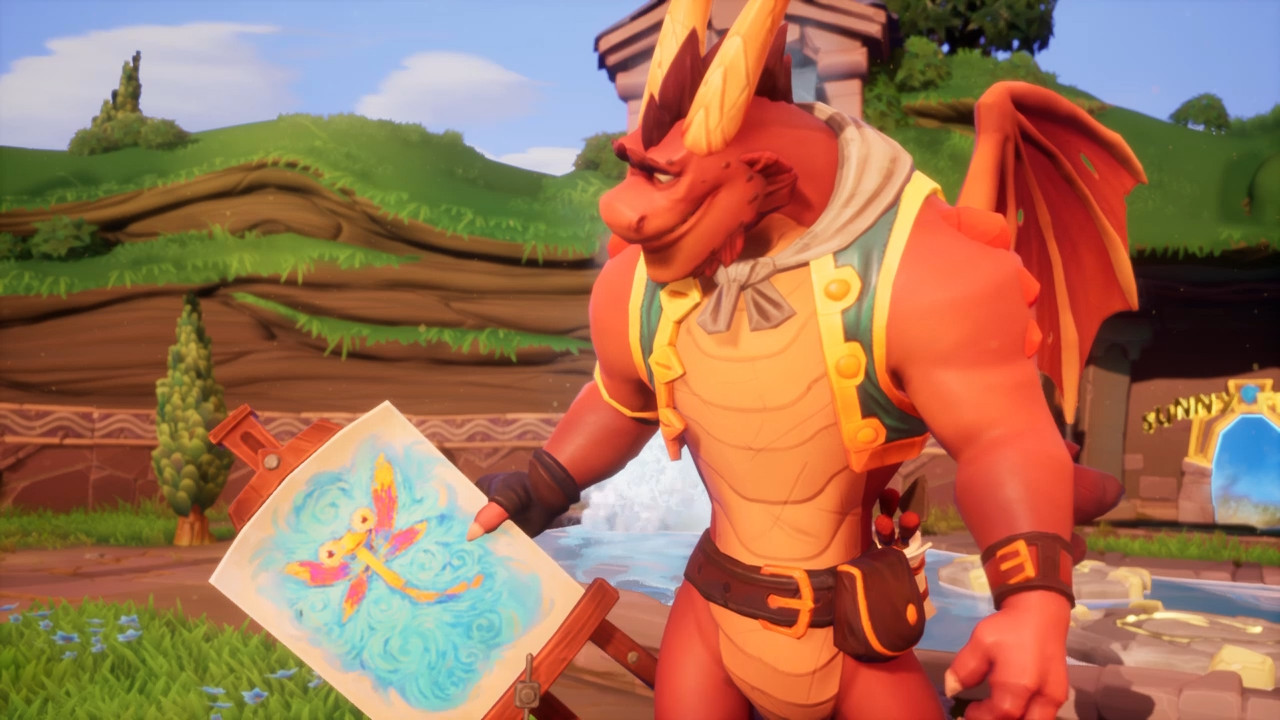
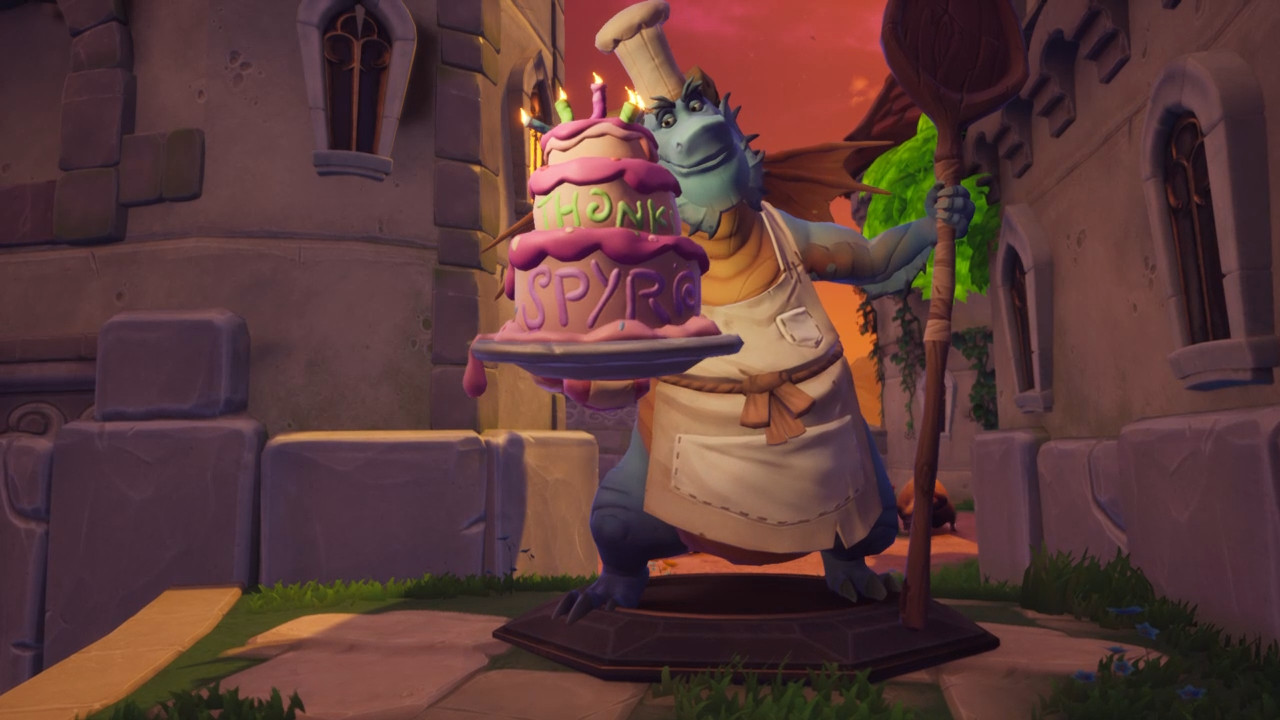
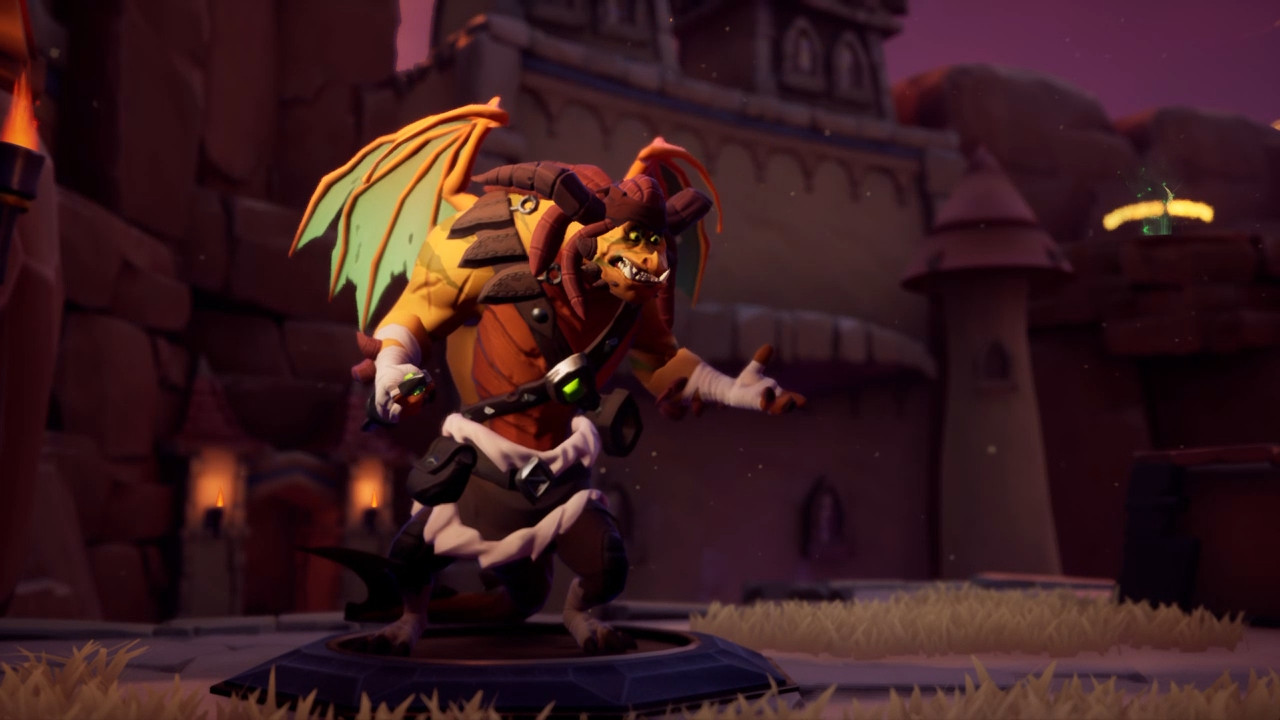
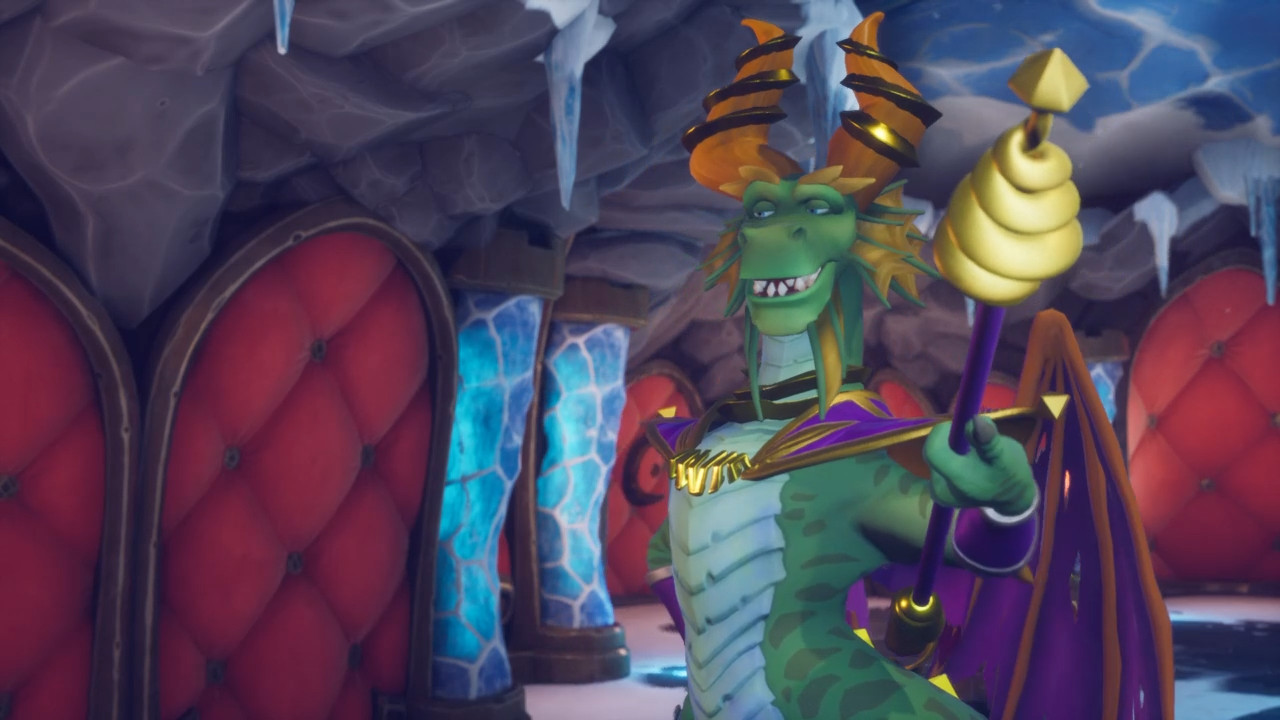
Spyro 1's levels were also handled fairly well. Visually they were fresh while still being faithful to the originals. I enjoyed some of the reinterpretations. I think the Beast Makers world in particular looks fantastic. I wouldn't quite say I prefer it to the original, but it's great.
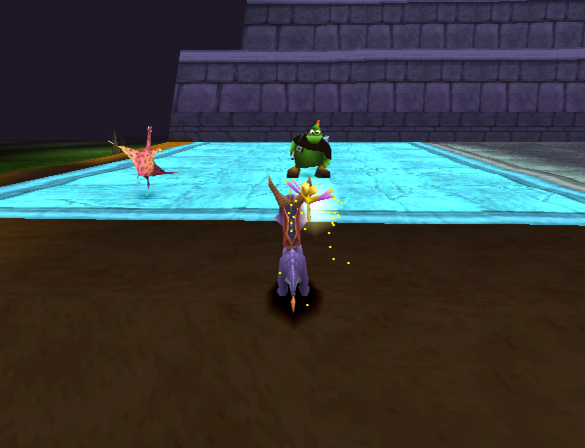

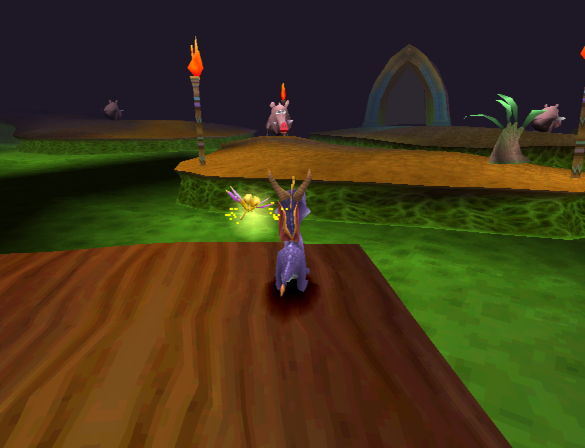

There were a few instances of bad interpretations and annoying visual effects, but these weren't really an issue until I got to Spyro 2 and 3. Reignited Spyro 1 generally feels way more polished than the remade sequels. In fact, most of my issues crop up in those games. I get the impression that the latter two games were rushed. For starters, they're buggy as hell. The original Spyro 2 and 3 certainly weren't perfect in this regard, but you typically wouldn't encounter glitches unless you were going out of your way to find them. I praised Spyro's controls, but all the extra gameplay styles and characters were wildly inconsistent. Agent 9's controls were a huge improvement, yet Sheila felt like crap. They also wasted a perfectly good opportunity to make Sparx's levels feel like not the worst thing ever.
These games also have lots of aesthetic issues. The carefully chosen color palettes of the original levels were not always respected. Sometimes they were, like in the level Hurricos, and I think it looks great. More often than not they either just didn't even consider the original color palette, or sloppily applied an overwhelming color filter to try and achieve the same effect. I really disliked the obnoxious purple tint of Breeze Harbor.
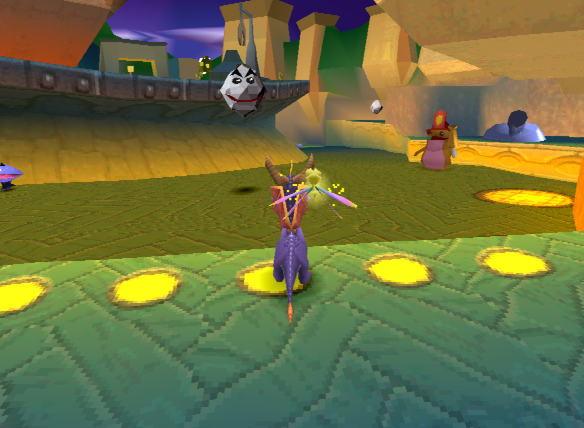
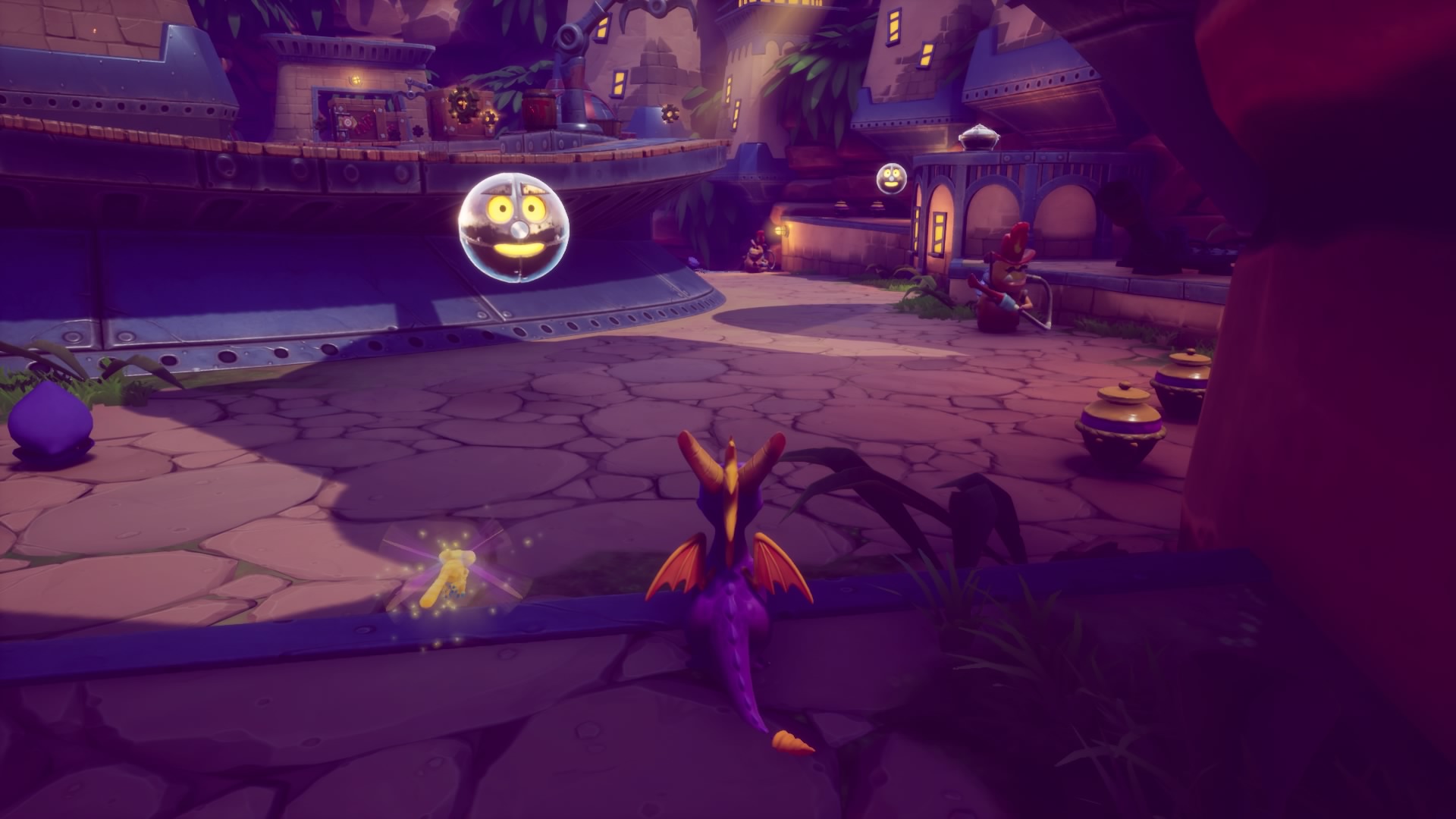
Any time you're underwater, the game puts a blue filter over the screen. This ruins the look of levels like Aquaria Towers, Seashell Shore, and Evening Lake.

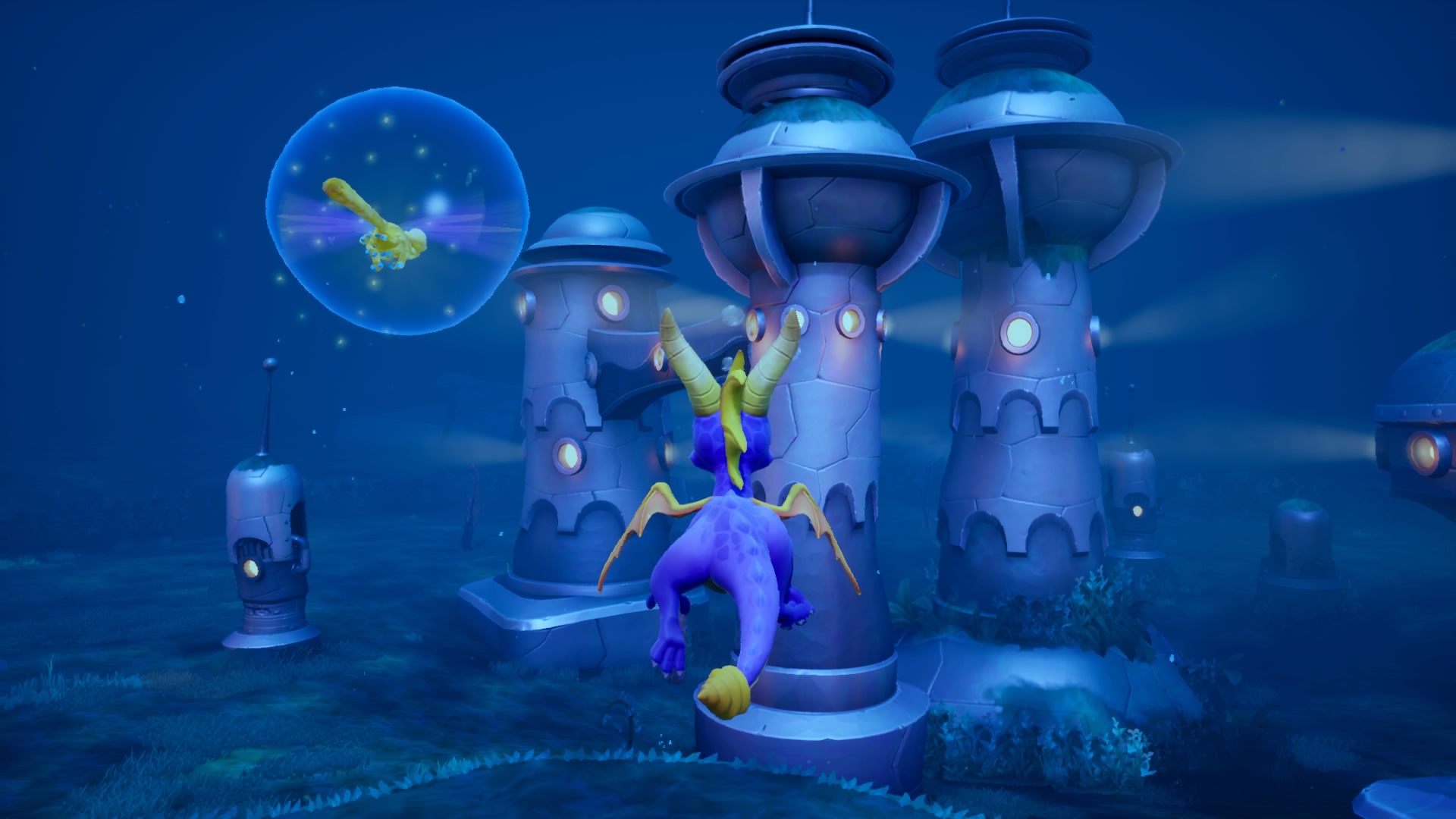
There were a few characters I liked. Spyro's model looks fantastic. I also liked the new designs for Zoe, Moneybags, and Bianca. Moneybags's voice actor was also pretty great. He sounds like a good middle ground between the voice actors for 2 and 3. I still think I prefer the old voices, but I enjoyed him in Reignited. Unfortunately, most of the other voices and character designs weren't that good in my opinion. I feel like they really butchered the cutscenes in Spyro 2. Watch the original cutscene after completing Glimmer and compare it to the remake. It feels like something was lost in translation.
Spyro and Elora's interaction in the original game just comes off as way more natural despite the limited animation. Spyro just got cat fished into saving an entire kingdom, so he's obviously a little on-edge. Still, he's a good guy, so he's going to do the right thing. When he sees Elora again he tries to strike up some awkward small talk: “So, you're like… a goat, or something. That's nice.” Elora gets offended and calls him a dork, as if to say “Hey, retard, I'm a faun. They live here, you uncultured filth.” Spyro is still apprehensive, so Elora has to convince him to help them. There's a real sense of urgency. In the remake, Spyro is unusually bright and happy for having been tricked into helping some people he doesn't know. The "dork" line just comes off as these two flirting after having met no more than five minutes ago. It's really awkward. By the way, the cutscenes were also re-scored. I feel like the score is trying to fill in gaps left by the bad voice acting. It isn't quite as bad as the remake of The Lion King, but it's pretty annoying. I could pick apart many other cutscenes in Spyro 2 and 3, but I think you get the idea.
I found a lot of the voice acting to be distractingly bad, especially for Elora. I don't see why they couldn't have gotten the original voice actress back. Confusingly, Hunter was also given a new voice, even though his voice actor came back to voice Ripto. When it came to the NPCs, I basically prefer all of them in the original. There were lots of great little gags that the remake just misses out on. I loved how the fauns in Fracture Hills had valley girl accents. In the remake they were just given (obviously fake) Scottish accents. I don't understand why this was changed. All this is nothing compared to the most unforgivable sin of Reignited: Juliet is just voiced by a woman now. There's no joke or punchline anywhere to be seen or heard. It might honestly be the most shockingly stupid and unnecessary change in any remake ever. I mention this because it's part of the game's personality. Reignited just feels like it had all the charm and charisma sucked out of it. Oh, and I haven't even mentioned all the annoying ways Toys for Bob tried to inject their own unfunny jokes.
With all this in mind… is Reignited really a bad game? I can imagine someone never having played the original games still enjoying it. I think this begs an important question: how much credit goes to Insomniac and how much credit goes to Toys for Bob? This is going to sound harsh, but I think that Reignited is good in spite of Toys for Bob's efforts. If it weren't for the solid foundation laid down by Insomniac, I don't think people would care all that much about these games. At least not Spyro 2 and 3.
Still, I haven't gotten to the worst part of Reignited. This game reminds me of just how terrible modern games are. If you bought the game on PS4, you needed to download a 20GB patch on day one. That patch contains the entirety of Spyro 2 and 3. Kids nowadays will never know the joy of getting a game for Christmas and loading it up for the first time, or bringing their original copy of Crash Team Racing to a friend's house. Instead, you get to wait 45 minutes (if you're lucky) for the game to install. There's plenty of annoying corner-cutting on display even in Spyro 1. The original's seamless level transitions have been replaced by obnoxiously long load times. The performance on base PS4 is also really bad. It frustrates me because these were not issues that the original games had. Remember that the original Spyro the Dragon from over 20 years ago was a technical marvel that pushed the PS1 to its limits while still feeling smooth. The load times were nice and short, and cleverly hidden by a cool animation of the game tallying up your gems. After 20 years you'd think this wouldn't be an issue.
It is for that reason that I can't really recommend the Reignited
Trilogy, not even for the morbid curiosity of seeing what was changed. I
can't excuse these glaring technical flaws in good conscience and I don't feel
comfortable supporting sleazy business practices like this. Just download
the original games and play them in an emulator legally buy a copy of the
original games and play them on your trusty, legally-owned Sony
PlayStation™. No patches needed.
I hope you all enjoyed this article. I'm sorry to leave off on such a negative note, but I really wanted to include a warning about the Reignited Trilogy. Contrary to what some people may say, I really don't enjoy being negative. It's fun to be snarky in the moment, but when the high wears off I find myself feeling really exhausted for no real benefit. I'll occasionally look back at even some more recent videos and cringe at my attitude or my over-use of curse words. I don't see anything wrong with strong criticism and I'll continue to dish that out if I feel it's necessary. I just don't ever want to sound like a breadtuber. I never want to come off like I'm above it all or that I'm difficult to approach. I hope this article has proven to be a good change of pace. My review of Reignited ended up being more negative than I had planned, but I went back and edited it to try to keep the insults "above the belt." Hopefully I did a good job. Thank you for reading.
I will not apologize for my righteous anger at Juliet.